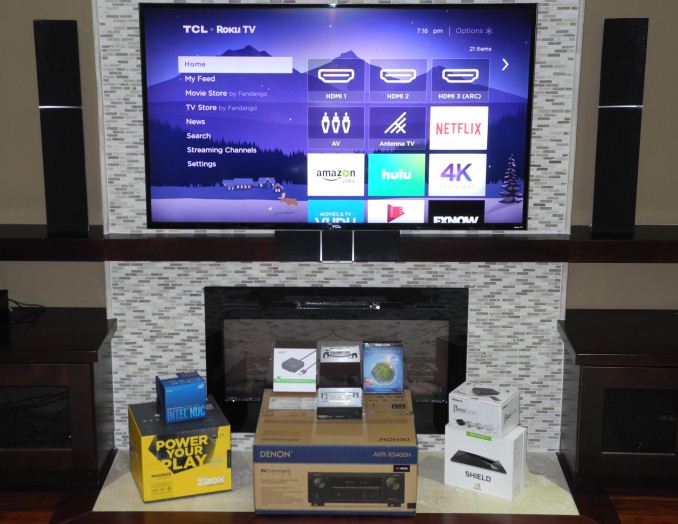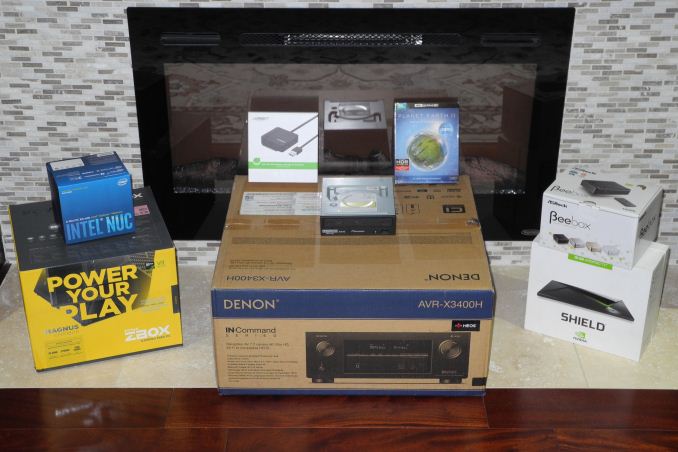A Budget Home Theater & PC Setup: 4K, HDR, UHD Blu-ray, and More
by Ganesh T S on December 26, 2017 8:30 AM EST
The days of bulky HTPCs with built-in optical drives, massive internal storage arrays, and integrated TV tuners are long gone. The advent of over the top (OTT) online streaming services has moved a lot of functionality to the cloud. As NAS units become more powerful, it has made sense to move local media files to a central repository. All these have enabled the TV-connected PC to become more compact. Unless the consumer has specific requirements (like, say, high quality gaming), even ultra-compact form factor (UCFF) machines such as the Intel NUCs can fit the bill.
Home Theater Components: Keeping up with the Times
The primary functionality of HTPCs has evolved to become one of a powerful and versatile media player. However, recent advances such as 4K and high dynamic range (HDR) videos, as well as stricter DRM requirements such as HDCP 2.2 for premium content have made the perfect HTPC platform difficult to achieve. Before delving deeper into these new advances, it is helpful to have some insight into how the landscape has changed over the last decade or so. The advancements in that timeframe have meant that next attractive home theater feature was always around the corner. In the initial days of 720p televisions and other home theater equipment, it was Full HD (1080p). As 1080p became widespread, it was HD audio bitstreaming. After that, 3D support was sought after. A brief lull ensued before the market started slowly getting ready for 4K.
Over the last year or so, we have seen the appearance of displays and audio/video receivers (AVRs) supporting HDMI 2.0 / HDCP 2.2 along with HDR / Dolby Vision. Despite the announcement of HDMI 2.1, I believe that we have reached a point where it is possible to purchase a relatively inexpensive home theater and HTPC configuration without worrying about it getting obsolete within the the next 3 to 5 years.
On the media side, OTT streaming services have become popular to the extent that Netflix and YouTube moved to offer 4K videos to consumers ahead of Blu-rays. Fortunately, many modern PCs are capable of 4K Netflix playback, though HDR is available only on a subset of those configurations. UHD Blu-ray playback support is available through CyberLink PowerDVD 17. However, the hardware requirements are a lot more specific compared to premium OTT services. UHD Blu-ray playback with HDR requires that the home theater components fulfill additional requirements.
Building a Home Theater on a Budget
I started work on this home theater piece back in June 2017. The aim was to present a setup (TV, AVR, and HTPC) with all the bells and whistles, yet light on the wallet. While the TV (TCL 55P607) and the AVR (Denon AVR X3400H) were easy to narrow down based on the feature requirements and budget, the PC side proved to be more challenging. Our core requirements (compact form factor, 4K Netflix support, and HDR capability) narrowed down the choices to a NVIDIA Pascal GPU-equipped PC or a Kaby Lake PC with HDCP 2.2 capabilities. UHD Blu-ray support further narrowed this down to certain Kaby Lake PCs with a HDMI 2.0 / HDCP 2.2 display output.
In the course of our evaluation, we found that consumer electronic (CE) equipment almost always received features ahead of HTPC platforms. Keeping this in mind, we ended up evaluating a number of options for the fulfillment of HTPC duties
- Roku Smart TV platform in the TCL 55P607
- NVIDIA SHIELD Android TV (SATV)
- Zotac ZBOX MAGNUS EN1080K
- ASRock Beebox-S 7200U
- Intel NUC7i7BNHX
Prior to looking at the performance of these options, it will be of interest to readers to delve deeper into our choice for the other home theater components. Earlier this year, I happened to embark on a house remodel, and I took that opportunity to revamp the HTPC test components used in our system reviews. Our choice of components is geared towards a typical family room (15' x 15') home theater.











191 Comments
View All Comments
mikato - Thursday, January 18, 2018 - link
Great point, and I also agree... unless you want local storage for media content. Sure I guess the response would be to have a PC (when we had been leaving out the PC) or a NAS feed content with DLNA or whatever that is with Plex or Kodi over the network. But then you have quite a bit more than just whatever box or stick. And if you wanted to bring your content with you to a friend’s house, you couldn’t do that, when you might be able to pretty easily with one of the UCFF PCs with a disk in it. Plus I’ll add that would be able to play anything, when for instance you might not be able to play YouTube with your Amazon stick or play Amazon with your Google stick.We’re close, but not quite there yet. What is there does cover things enough for a lot of people though.
Duto - Friday, December 29, 2017 - link
A TCL TV set?, really? , unbelievable!rapster - Friday, December 29, 2017 - link
Thank you for your thoughtful review of some of the tricks, traps, and solutions of the 4K HDR space. As someone who recently had to deal with a few of the challenges you worked through I really appreciate it. Your recommendation of the NVIDIA Shield is especially well-considered and would have saved me a lot of time for my applications. The comments section here has some gold to be mined as well.As for budget: I paid twice as much for my receiver as the $999 one you recommended and still consider it to be a budget unit. Anybody who has been to a "real" media equipment store understands this. Sorry to be "that guy" on my first post here, but I might suggest it's time for some folks (cough ddriver) to leave mom's basement and that job at the mall and get out more.
ronraxxx - Friday, December 29, 2017 - link
THANK YOU - I was getting so triggered reading these comments. "Budget" is relative. A brand new Kia costs $10,000 - it's still a *budget* vehicle in the world of new cars. Real home theater equipment is expensive - the key word being "THEATER." If you want a true, immersive, theater-like experience it usually is very expensive. If you only have $1000 to spend on your home "theater" I hate to break it to you but the TV, soundbar, and Roku that fits your budget isn't really a theater at all, unless you're in a dorm room.Reflex - Friday, December 29, 2017 - link
This right here. People get hung up on the word Budget. If the author could do one thing differently IMO it would be to define what the actual price tiers he is using are. People could yell all they wanted about how a $500-2000 range for budget receives isn't 'budget' in their world, but at least they'd know the author's definition.Honestly the compromise he made in this that I wouldn't have is the TV. Nothing against TCL, but seriously if you are building a theater it seems like what you look at should be the number one priority. I spent about $3k in total on my setup (budget!) and $2k of that was the tv. There is also the consideration of space, in my case the space permitted isn't theater quality or size, so the 'budget' consideration is different as spending $10k on speakers would gain me nothing in the space allowed.
I'd like to see Anandtech cover this space. I like the practical approach they took here and the mostly plain language. I like how the final reccomendation list had options on most of the items so people could easily define their priorities. But if they do go forward they should define some basic terms like what is considered 'budget' for both individual components and for a total setup, and what kind of spaces they are trying to address (dedicated theater? living room? corner of a bedroom?). With that in place most of the arguments in this thread become pedantic noise.
Bullwinkle-J-Moose - Saturday, December 30, 2017 - link
" The comments section here has some gold to be mined as well."---------------------------------------------------------------------------------------
Well thank you for those kind words Rapster, and remember kids......
If you can't sing, you can always Rap!
FreckledTrout - Sunday, December 31, 2017 - link
I agree completely. I have about 2.5K into my home theater sound(not including anything not sound related) and I felt that was rather budget oriented. I did put about $700 into a SVS subwoofer which in my opinion is what makes or breaks most home theater builds.Lau_Tech - Friday, December 29, 2017 - link
Assuming the point of the article was to promote the receiver... Why not just focus on reviewing the receiver? Many sites have also compared htpc with Xbox and ps4s.. An article on that would have been useful as well.As it stands the article simply feels amateurish and unfocused. What article on setting up a home theater (budget or otherwise) focuses on the receiver and htpc at the cost of the cornerstone elements:TV and speakers?
I truly do not know why efforts were expended in this new, odd direction when other product reviews are in higher demand.
HStewart - Friday, December 29, 2017 - link
One thing I curious about is GPU support for UHD. It appears you need Intel 630 or higher in Kaby Lake or the Xbox. Note even thought Xbox has older generation CPU and GPU, Microsoft must have modified the GPU to support UHD 4k. My guess is both NVidia and AMD will follow suit next year.One things that this defunct is claims that Kaby Lake is no different than previous generations Intel processors. And unfortunately for me having older i7, it can't be claimed that Intel is just doing this for people to buy new cpus - since both NVidia and AMD don't support it.
The Jedi - Saturday, December 30, 2017 - link
Thanks Ganesh, good article. With a 4K Android TV and an Ultra HD Blu-Ray player, the HTPC's days are past. Me personally, I will keep my Windows Media Center HTPC for the DVR functionality, indefinitely.The standalone UHD Blu-Ray player is simpler, cheaper, and no-nonsense.
Android TV is something for services to rally around. Even with the security platform provided by Kaby Lake/Coffee Lake and Windows 10, services besides Netflix are not rushing to bring 4K to the PC.
A year ago I was so psyched about upgrading to a Kaby Lake i7 to be on the latest system and get onboard and support the PC 4K ecosystem. What impressed me was that Intel was working on overcoming the challenges that kept 4K discs and 4K services away from the PC. But, I decided I didn't really need it or Coffee Lake, and it was cheaper to keep my investment in DDR3. I upgraded to a Haswell Refresh instead.